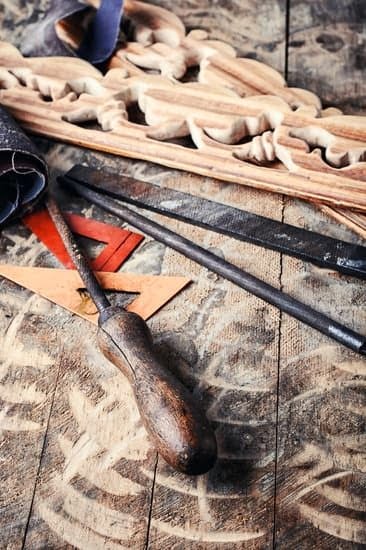What are the tools and materials in woodworking? Woodworking is an ancient art that has been practiced for centuries, playing a significant role in construction, furniture making, and artistic expression. In this article, we will explore the essential tools and materials used in woodworking, from traditional hand tools to modern power machinery. Understanding these tools and materials is crucial for anyone interested in pursuing woodworking as a hobby or profession.
Woodworking has a rich history and cultural significance, with evidence of early woodworking dating back to ancient civilizations. Today, it remains a timeless craft that demands precision, creativity, and skill. The tools and materials used in woodworking have evolved over time but continue to serve as the foundation for creating beautiful and durable wood products.
The following sections will delve into the different categories of tools and materials used in woodworking, including essential hand tools, power machinery, wood materials, additional supplies such as adhesives and finishes, safety precautions, maintenance tips, and recommended resources for acquiring high-quality tools and materials. Whether you are a novice woodworker or an experienced professional, understanding the intricacies of these tools and materials is essential for successful woodworking projects.
Essential Hand Tools in Woodworking
Woodworking involves the use of a variety of tools and materials, both traditional and modern, to create beautiful and functional wood pieces. Essential hand tools play a crucial role in the woodworking process, allowing artisans to shape, carve, and refine their projects with precision and attention to detail. Some commonly used hand tools in woodworking include chisels, hand saws, planes, and carving tools.
Chisels are indispensable for woodworking, as they are used for cutting or carving out wood to create intricate designs or smooth surfaces. Hand saws come in different types such as crosscut saws and rip saws, each serving specific cutting purposes based on the wood grain. Planes are essential for shaping and smoothing wood surfaces by removing thin layers of material. Carving tools, including gouges and knives, enable woodworkers to precisely sculpt and carve detailed designs into wood.
Each of these essential hand tools plays a significant role in woodworking projects by allowing artisans to execute precise cuts, shapes, and finishes on their creations. These tools require skillful handling and mastery to achieve the desired results in woodworking projects.
| Hand Tool | Specific Uses |
|---|---|
| Chisels | Cutting or carving wood |
| Hand Saws | Crosscutting or ripping based on wood grain |
| Planes | Shaping and smoothing surfaces |
Overall hand tools greatly influence the outcome of any given woodworking project much more than most people would anticipate so it is so important that before jumping deep into any such endeavors you should be well equipped with all the necessary hand-held matchless utensils which is sure fire way to save your from dire stresses i.e. Chisels, handsaw etc.
Power Tools and Machinery in Woodworking
When it comes to woodworking, power tools are essential for enhancing efficiency and precision in various woodworking projects. These tools are designed to make cutting, shaping, and finishing wood easier and more accurate. In this section, we will explore the different types of power tools commonly used in woodworking and discuss their specific functions.
Types of Power Tools
One of the most common power tools used in woodworking is the table saw. This versatile tool is highly effective for making straight cuts, ripping boards, and creating beveled edges. Another popular power tool is the band saw, which is perfect for cutting intricate shapes and curves in wood. Additionally, routers are widely used for hollowing out areas of a piece of wood as well as creating decorative edges.
The Role of Power Tools in Woodworking
Power tools play a crucial role in increasing productivity while maintaining accuracy in woodworking projects. The use of these tools allows woodworkers to work more efficiently by reducing the time it takes to complete tasks such as cutting, shaping, and carving wood. With the help of power tools, intricate designs can be achieved with precision and consistency.
Safety Precautions When Using Power Tools
While power tools are incredibly useful in woodworking, they also pose certain risks if not handled with caution. It’s important for woodworkers to observe safety precautions when using these tools to prevent accidents or injuries. Safety measures such as wearing eye protection, using push sticks for table saws, and avoiding loose clothing can help minimize potential hazards when operating power tools.
As we’ve seen, power tools are indispensable for modern woodworking projects. They offer increased efficiency and precision that hand tools simply cannot match. Understanding the different types and functions of power tools is essential for any woodworker looking to take their craft to the next level.
Remember that each tool requires proper training and practice before use Make sure you have a clear understanding of how each power tool works before operating it.
Types of Wood Materials
Woodworking relies heavily on the use of different types of wood materials to bring projects to life. Understanding the characteristics and uses of each type of wood is essential for creating durable and beautiful pieces. In this section, we will explore the various types of wood used in woodworking, including hardwoods, softwoods, and engineered wood.
Hardwoods
Hardwoods are typically sourced from deciduous trees and are known for their durability and strength. Some common examples of hardwoods used in woodworking include oak, maple, cherry, and walnut. Due to their density, these woods are often used for furniture making, cabinetry, flooring, and decorative items. Their natural beauty and ability to withstand wear and tear make them sought-after materials in woodworking projects.
Softwoods
Softwoods come from coniferous trees and are generally more readily available than hardwoods. Pine, cedar, spruce, and fir are popular choices for softwood materials in woodworking. While softwoods may not be as dense or durable as hardwoods, they are often used for construction projects such as framing, outdoor furniture, decking, and interior trim work. Softwoods also have a natural warmth and charm that makes them desirable for many woodworking applications.
Engineered Wood
In addition to solid wood materials, engineered wood products have become increasingly popular in woodworking. Engineered wood includes plywood, particleboard, MDF (medium-density fiberboard), and laminates. These materials are made by binding or fixing the strands, particles or fibers together with adhesives or other methods to form composite materials. Engineered wood offers increased stability and uniformity compared to natural woods while allowing for expanded design possibilities. It is commonly used in cabinetry construction, paneling, furniture making,&.
and other woodworking applications due to its cost-effectiveness and versatility.
Understanding the different types of wood materials available is crucial when planning a woodworking project. Each type of wood has its unique qualities that can significantly impact the outcome of a project in terms of appearance.
durability,&and functionality.
When Selecting Materials for a Project,
It Is Important to Consider Factors Such As
the desired aesthetics, strength requirements, and environmental considerations.
to ensure the best results.
By Leveraging the Diverse Properties&of Hardwoods,
softwoods, and engineered woods, woodworkers can create stunning pieces that stand the test&of time.&.
Additional Materials and Supplies
Woodworking projects require more than just tools and wood materials. There are additional materials and supplies that play a crucial role in the success of a woodworking project. Whether it’s adhesives, finishes, or hardware, these items contribute to the overall quality and durability of the finished product. Here is a list of the additional materials and supplies commonly used in woodworking:
- Adhesives: Glue is an essential component in woodworking as it is used to join pieces of wood together. Common types of woodworking adhesives include wood glue, epoxy, and polyurethane glue.
- Finishes: Once a woodworking project is completed, finishes are applied to protect the wood from damage and enhance its appearance. Finishes can be stains, varnishes, lacquers, or oils.
- Hardware: Hardware such as screws, nails, hinges, knobs, and pulls are necessary for completing furniture pieces or other wooden structures. It’s important to choose hardware that complements the design and function of the project.
Selecting the right materials for a woodworking project is crucial for achieving the desired results. The type of adhesive used will affect the strength of joints while the finish can determine how long a piece will last in different environments. Additionally, choosing appropriate hardware ensures that the final product not only looks good but also functions as intended.
Woodworking enthusiasts should also consider sustainability when selecting additional materials and supplies for their projects. Using eco-friendly adhesives and finishes can reduce environmental impact while still producing high-quality work. When working with hardware, opting for recycled or repurposed items can also contribute to sustainable woodworking practices.
Overall, these additional materials and supplies are just as important as tools and wood materials in ensuring that a woodworking project meets high standards of quality and craftsmanship. By understanding the role each element plays in construction and finishing processes, woodworkers can elevate their projects to new levels of excellence.
Safety Precautions in Woodworking
Woodworking is a craft that requires the use of various tools and materials to create beautiful and functional pieces. However, it is important to prioritize safety when working with these tools to prevent accidents and injuries. Below are some safety precautions to keep in mind when using woodworking tools and materials:
- Always wear appropriate protective gear such as safety glasses, hearing protection, and dust masks to protect yourself from flying debris, loud noises, and airborne particles.
- Keep your work area clean and organized to avoid tripping over clutter or having objects fall onto you while working.
- Ensure that all power tools are switched off and unplugged when not in use to prevent accidental start-ups.
- Use push sticks or push blocks when operating power tools like table saws to keep your hands at a safe distance from the cutting blades.
In addition to these precautions, it is important to familiarize yourself with the specific safety guidelines for each tool and material you are using in your woodworking project. Always read the manufacturer’s instructions and follow best practices for handling woodworking equipment.
It is also crucial to receive proper training on how to use woodworking tools safely. Whether you are a beginner or an experienced woodworker, refreshing your knowledge of safety procedures can help prevent accidents in the workshop. By prioritizing safety measures, woodworkers can continue creating beautiful pieces while minimizing the risk of injury.
Maintenance and Care of Woodworking Tools
The maintenance and care of woodworking tools are essential for ensuring their longevity and optimal performance. Properly maintaining tools not only extends their lifespan but also contributes to the quality of woodworking projects. It is important to understand how to care for different types of tools and materials in order to maximize their utility.
One crucial aspect of maintaining woodworking tools is keeping them clean and free from debris or residue. This involves regular cleaning and inspection of tools after use, as well as proper storage to prevent corrosion or damage. For example, hand saws should be wiped down after each use to remove sawdust and any moisture that could lead to rusting.
In addition to cleanliness, regular sharpening and calibration of cutting edges and blades are necessary for optimal performance. Tools such as chisels, planes, and carving tools require sharpening to maintain their precision and efficiency. Proper sharpening techniques vary depending on the type of tool, so it is important to learn the specific methods for each.
Table saws are at the heart of many woodworking projects. Keeping the blades aligned and well-maintained is crucial for safety as well as accurate cuts. Regular blade inspection, cleaning, and alignment checks will ensure that the table saw operates smoothly and produces clean and precise cuts.
| Maintenance Tip | Care Action |
|---|---|
| Regular Cleaning | Wipe down tools after use with a clean cloth or brush to remove debris |
| Sharp Blades | Sharpen cutting edges on chisels, hand planes, saws regularly for optimal performance |
| Proper Storage | Store tools in a dry environment away from moisture or extreme temperatures |
Recommended Resources for Woodworking Tools and Materials
In conclusion, woodworking is a timeless art that requires a variety of tools and materials to bring creations to life. From essential hand tools like chisels and planes to power tools such as table saws and routers, each item plays a crucial role in the woodworking process.
Additionally, the type of wood used, including hardwood, softwood, and engineered wood, greatly impacts the outcome of a project. Understanding the properties and uses of different wood materials is essential for achieving desired results in woodworking.
It is also important to consider additional materials like adhesives, finishes, and hardware when undertaking woodworking projects. These supplementary items can greatly enhance the overall quality and durability of the finished product. Moreover, safety precautions should always be prioritized when working with woodworking tools and materials. Protective gear and adherence to safety guidelines are crucial in preventing accidents and injuries.
For those interested in pursuing woodworking as a hobby or profession, it is recommended to invest in high-quality tools and materials from reputable suppliers. Proper maintenance, care, and storage of woodworking tools are imperative for prolonging their lifespan and ensuring optimal performance. With the right tools, materials, resources, and knowledge of safety measures in place, individuals can embark on fulfilling woodworking endeavors with confidence and success.
Frequently Asked Questions
What Are the Woodwork Tools?
Woodworking tools can include a variety of items such as saws, chisels, planes, drills, sanders, clamps, and measuring tools. Each tool serves a specific purpose in cutting, shaping, smoothing, joining, and measuring wood to create various woodworking projects.
What Tools Are Needed to Begin Woodworking?
To begin woodworking, essential tools include a saw (such as a handsaw or circular saw), chisels for carving and shaping wood, a hammer for driving nails or adjusting pieces, screwdrivers for assembling or disassembling pieces, measuring tools like a tape measure and combination square for accuracy, and clamps to hold pieces securely while working on them.
What Are the Materials in Carpentry?
The materials used in carpentry often include different types of wood such as pine, oak, maple, cedar, or plywood. Additionally, carpenters use various fasteners like nails and screws for joinery.
Other materials may include wood glue for adhesive purposes and finishing materials like paint or varnish to protect the wood’s surface from wear and tear. These materials are essential for creating durable and aesthetically pleasing wooden structures or furniture pieces.

Hi everyone! I’m a woodworker and blogger, and this is my woodworking blog. In my blog, I share tips and tricks for woodworkers of all skill levels, as well as project ideas that you can try yourself.





